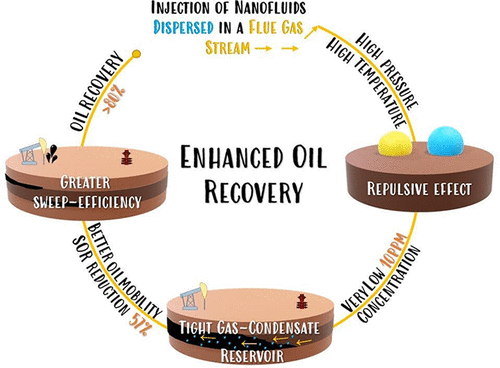当前位置:
X-MOL 学术
›
Energy Fuels
›
论文详情
Our official English website, www.x-mol.net, welcomes your
feedback! (Note: you will need to create a separate account there.)
Injection of Nanofluids with Fluorosurfactant-Modified Nanoparticles Dispersed in a Flue Gas Stream at Very Low Concentration for Enhanced Oil Recovery (EOR) in Tight Gas–Condensate Reservoirs
Energy & Fuels ( IF 5.2 ) Pub Date : 2020-09-22 , DOI: 10.1021/acs.energyfuels.0c02689 Dahiana Galeano-Caro 1 , Juan P. Villegas 1 , Juan H. Sánchez 2 , Farid B. Cortés 1 , Sergio H. Lopera 2 , Camilo A. Franco 1
Energy & Fuels ( IF 5.2 ) Pub Date : 2020-09-22 , DOI: 10.1021/acs.energyfuels.0c02689 Dahiana Galeano-Caro 1 , Juan P. Villegas 1 , Juan H. Sánchez 2 , Farid B. Cortés 1 , Sergio H. Lopera 2 , Camilo A. Franco 1
Affiliation

|
The main objective of this work is to evaluate the effect of nanofluids formed by surface-modified nanoparticles with a fluorosurfactant dispersed in a flue gas stream at low concentrations as an enhanced oil recovery (EOR) process applied to a tight gas–condensate reservoirs (TGCR). This research is a continuation of our previous study (doi.org/10.1021/acsami.9b22383) in which nanoparticles of γ-Al2O3 and MgO modified with a short-chain fluorinated anionic surfactant (SY) at 30% by weight were developed. Here, the nanomaterials were used for preparing nanofluids (NF) at different concentrations to improve the mobility of the liquids in TGCR. Contact angle tests under high-pressure and high-temperature (HPHT) conditions were performed from 5 to 276 bar and at a constant temperature of 80 °C through the sessile drop technique to select the best nanofluid that generates a gas-wettability for EOR operations. Interfacial tension (IFT) measurements at high pressure (276 bar) and high temperature (80 °C) were also conducted to determine the selectivity of nanofluids to locate at the rock–fluid interface. The nanoparticles with superior performance were further evaluated through coreflooding tests at reservoir conditions of overburden pressure of 448 bar, pore pressure of 276 bar, and a temperature of 80 °C in a tight sandstone outcrop. The best results found for the contact angle and IFT at HPHT were obtained for the nanofluid of γ-alumina nanoparticles functionalized with fluorosurfactant at 30% by weight (AlSY30) dispersed in water at a concentration of 300 mg·L–1 (AlSY30-NF). The contact angle results obtained at reservoir conditions at 276 bar and 80 °C were 122 ± 2° and 119 ± 1° for water and oil, respectively. Also, IFT tests showed the preference of these nanofluids to be located at the rock–fluid interface and thus generate greater performance from the injected treatments to modify the rock wettability. These results are supported by a more than 95% increase in the energy binding to the oil/brine (ΔE) interface of AlSY30 nanoparticles than MgSY30 nanoparticles. A novel coreflooding test was performed by dispersing the nanofluid at different concentrations (from 0 to 300 mg·L–1) in a flue gas stream. A low concentration of 10 mg·L–1 resulted in a residual oil saturation (Sor) reduction of 57% and an increase in oil recovery of approximately 23% relative to the flue gas in the absence of nanofluid. A synergistic effect between a wettability alteration and a decrease in IFT occurred due to nanofluid dispersal in the flue gas stream. The results obtained in this study are expected to promote innovative and efficient technology for dispersed nanofluid injection as a recovery method in tightly condensed gas fields with excellent performance at low concentrations.
中文翻译:

用氟表面活性剂改性的纳米颗粒以非常低的浓度分散在烟道气中注入纳米流体,以提高致密气-凝析油藏中的石油采收率(EOR)
这项工作的主要目的是评估将表面改性的纳米颗粒与含氟表面活性剂以低浓度分散在烟气流中形成的纳米流体的作用,以此作为对致密气凝析油藏(TGCR)的强化采油(EOR)过程)。这项研究是我们以前的研究(doi.org/10.1021/acsami.9b22383),其中纳米颗粒的延续的γ-Al 2 Ø 3并开发了用短链氟化阴离子表面活性剂(SY)改性的MgO(按重量计30%)。在这里,纳米材料用于制备不同浓度的纳米流体(NF),以提高液体在TGCR中的迁移率。通过固定滴技术,在5至276 bar的高压和高温(HPHT)条件下,于80°C的恒定温度下进行了接触角测试,以选择能为EOR操作产生气体润湿性的最佳纳米流体。还进行了在高压(276 bar)和高温(80°C)下的界面张力(IFT)测量,以确定纳米流体位于岩石-流体界面的选择性。通过在致密砂岩露头的上覆压力为448 bar,孔隙压力为276 bar,温度为80°C的储层条件下,通过岩心驱替测试,进一步评估了性能优异的纳米颗粒。对于以30%(重量)的含氟表面活性剂(AlSY30)功能化的浓度为300 mg·L的氟表面活性剂官能化的γ-氧化铝纳米颗粒的纳米流体,获得了在HPHT上的接触角和IFT的最佳结果。–1(AlSY30-NF)。水和油在276 bar和80°C的储层条件下获得的接触角结果分别为122±2°和119±1°。同样,IFT测试表明,这些纳米流体更倾向于位于岩石-流体界面,因此通过注入处理来改善岩石的润湿性可产生更高的性能。与MgSY30纳米颗粒相比,AlSY30纳米颗粒与油/盐水(ΔE)界面的能量结合增加了95%以上,从而支持了这些结果。通过将不同浓度(0至300 mg·L –1)的纳米流体分散在烟气流中进行了新颖的岩心驱替试验。10 mg·L –1的低浓度相对于没有纳米流体的情况下的烟道气,残留油饱和度(Sor)降低了57%,采油率提高了约23%。由于烟道气流中的纳米流体分散,在润湿性改变和IFT降低之间产生了协同效应。这项研究中获得的结果有望促进分散纳米流体注射的创新和有效技术,作为在低浓度下具有优异性能的紧密冷凝气田中的一种回收方法。
更新日期:2020-10-16
中文翻译:

用氟表面活性剂改性的纳米颗粒以非常低的浓度分散在烟道气中注入纳米流体,以提高致密气-凝析油藏中的石油采收率(EOR)
这项工作的主要目的是评估将表面改性的纳米颗粒与含氟表面活性剂以低浓度分散在烟气流中形成的纳米流体的作用,以此作为对致密气凝析油藏(TGCR)的强化采油(EOR)过程)。这项研究是我们以前的研究(doi.org/10.1021/acsami.9b22383),其中纳米颗粒的延续的γ-Al 2 Ø 3并开发了用短链氟化阴离子表面活性剂(SY)改性的MgO(按重量计30%)。在这里,纳米材料用于制备不同浓度的纳米流体(NF),以提高液体在TGCR中的迁移率。通过固定滴技术,在5至276 bar的高压和高温(HPHT)条件下,于80°C的恒定温度下进行了接触角测试,以选择能为EOR操作产生气体润湿性的最佳纳米流体。还进行了在高压(276 bar)和高温(80°C)下的界面张力(IFT)测量,以确定纳米流体位于岩石-流体界面的选择性。通过在致密砂岩露头的上覆压力为448 bar,孔隙压力为276 bar,温度为80°C的储层条件下,通过岩心驱替测试,进一步评估了性能优异的纳米颗粒。对于以30%(重量)的含氟表面活性剂(AlSY30)功能化的浓度为300 mg·L的氟表面活性剂官能化的γ-氧化铝纳米颗粒的纳米流体,获得了在HPHT上的接触角和IFT的最佳结果。–1(AlSY30-NF)。水和油在276 bar和80°C的储层条件下获得的接触角结果分别为122±2°和119±1°。同样,IFT测试表明,这些纳米流体更倾向于位于岩石-流体界面,因此通过注入处理来改善岩石的润湿性可产生更高的性能。与MgSY30纳米颗粒相比,AlSY30纳米颗粒与油/盐水(ΔE)界面的能量结合增加了95%以上,从而支持了这些结果。通过将不同浓度(0至300 mg·L –1)的纳米流体分散在烟气流中进行了新颖的岩心驱替试验。10 mg·L –1的低浓度相对于没有纳米流体的情况下的烟道气,残留油饱和度(Sor)降低了57%,采油率提高了约23%。由于烟道气流中的纳米流体分散,在润湿性改变和IFT降低之间产生了协同效应。这项研究中获得的结果有望促进分散纳米流体注射的创新和有效技术,作为在低浓度下具有优异性能的紧密冷凝气田中的一种回收方法。











































 京公网安备 11010802027423号
京公网安备 11010802027423号